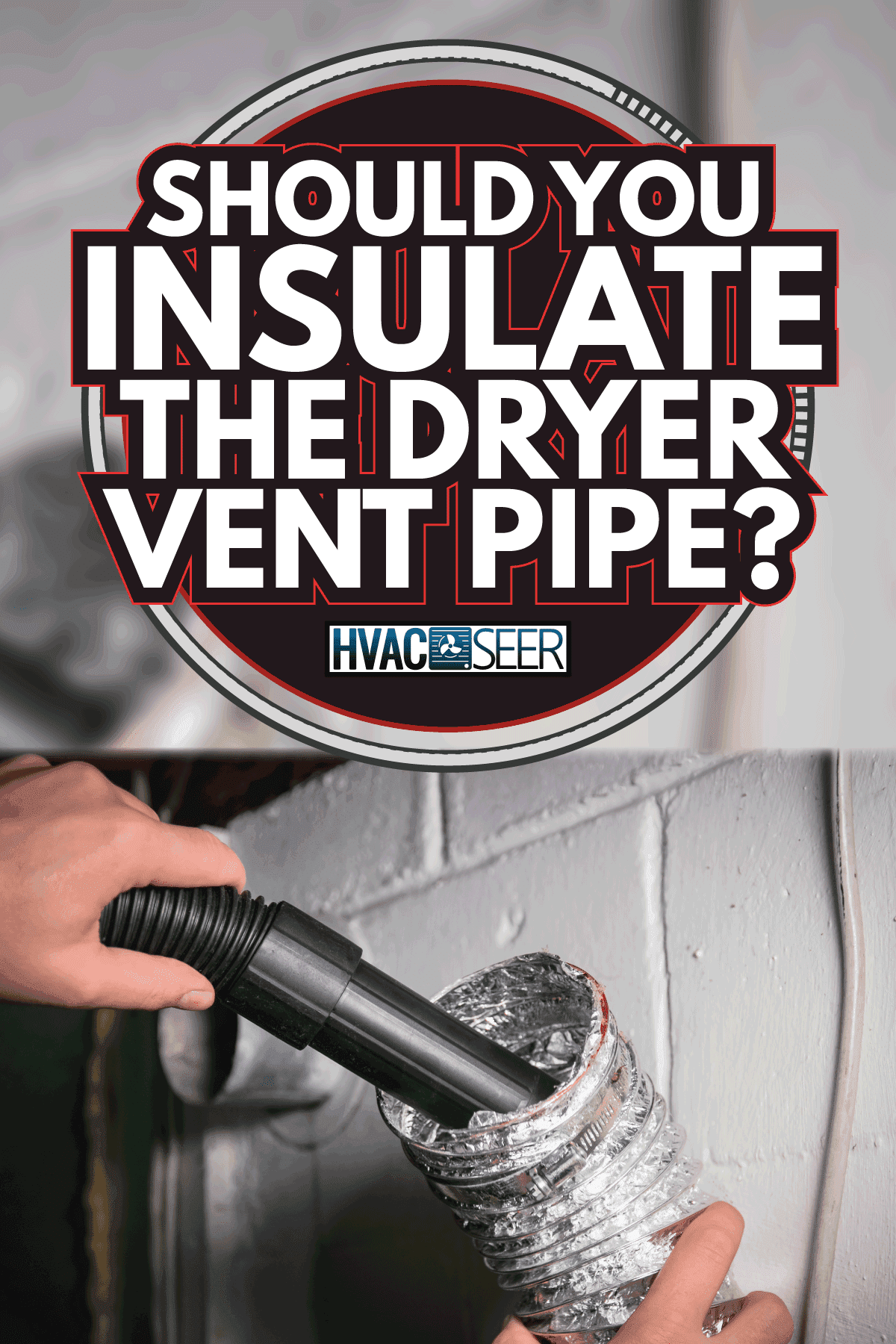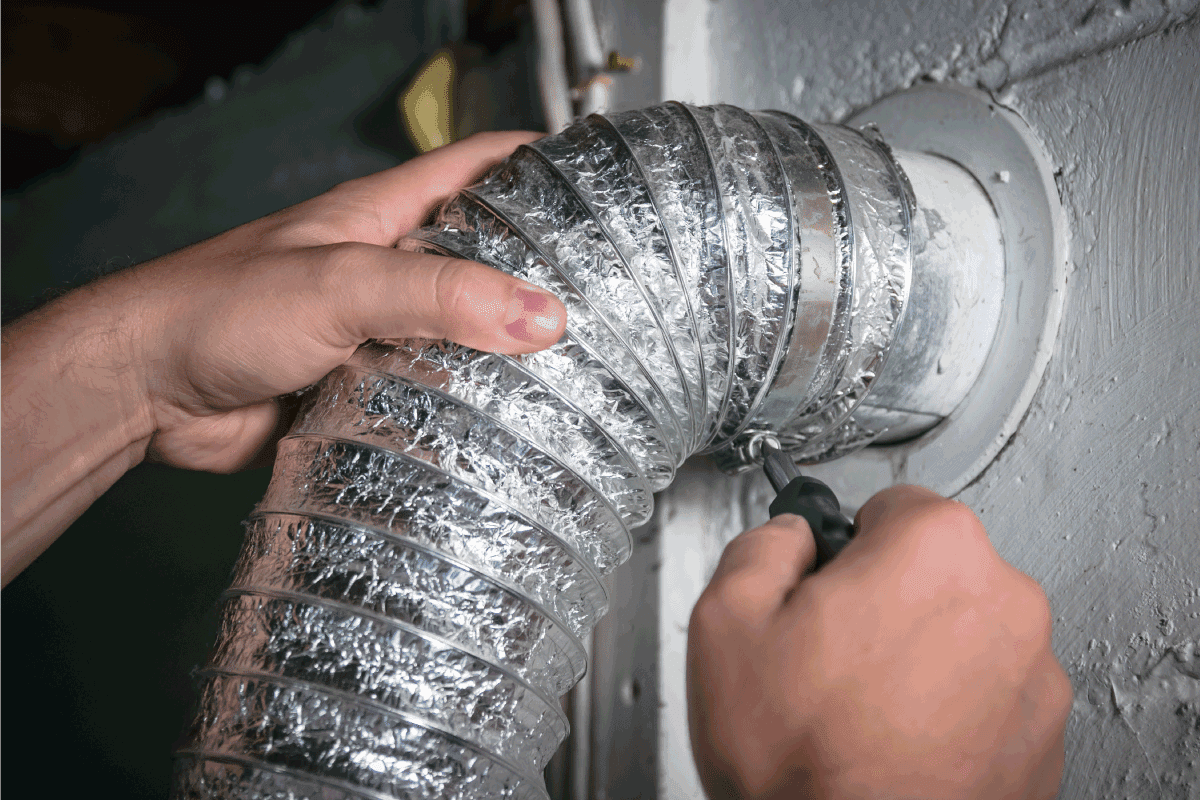Nearly every home in the US comes with a clothes dryer. These all should feature a vent pipe. But specifically, you are wondering if you should insulate the dryer vent pipe and how to accomplish this goal. In this post, we combine industry professional knowledge and up-to-date research to answer your question thoroughly.
Whether you should insulate your dryer vent or not depends on its location. If the dryer duct is within the home or a heated basement, there is no need or reason to insulate the duct/vent pipe. However, if the dryer duct runs through an unheated basement or crawlspace—insulation is highly recommended.
Keep reading the rest of this post for the reasoning behind the above recommendation. Following this, we cover the two primary methods for insulating dryer vent pipes. To conclude, we discuss the answers to many questions related to the topic of this post.

Building Science of Dryer Vent Pipes
Dryer vent pipes, also commonly referred to as dryer ducts, carry wet hot air from within the dryer to the outside of the home. Usually, this air is also full of dryer lint (or bits of clothes fuzz).
It is important to move the hot wet air of a dryer vent to the outside of a home because if that air is blown inside the home, the high water content will lead to rot, mold, and structural issues. For this reason, it is almost always building code to include a vent and vent pipe with your dryer.
While the above case for why to vent the dryer is relatively straightforward, the reasoning for insulating or not insulating the dryer vent is a little more complicated.
To learn more about the full requirements of laundry room ventilation, read this great article from HVAC Seer: Does A Laundry Room Need Ventilation? [Complete Dryer Ventilation Guide].
When to Insulate Dryer Ducts
When dryer ducts pass through unheated spaces, the hot air within them is significantly warmer than the air they are passing through. This is the case for crawlspace and unheated basements.
This fact interacts with the water retention capabilities of air. According to this article from the Environmental Protection Agency, warm air can hold significantly more water than cold air. This phenomenon is well demonstrated by the condensation that appears on bathroom and kitchen windows during the winter.

What happens is the warm wet air within your dryer ducts passes by the colder outside air. This leads to localized air cooling and moisture condensation inside the duct walls. The moisture build-up is not serious immediately but can lead to significant problems over time.
The long-term issues include the following. Water can leak back into your home. The dryer vent can rust or corrode and break, which means the wet air gets into the building to cause problems. The condensation can lead to indoor mold. And in extreme cases, this issue will cause structural issues.
Therefore, if your dryer duct passes through an unheated space of any kind, be sure to take the time to insulate. Usually, dryer duct runs are relatively short, making the cost and difficulty of this project worthwhile.
When Dryer Duct Insulation is Unneeded

By the logic discussed in the above subsection, dryer vent insulation is not necessary when the duct passes through heated space. This is because the temperature difference inside and outside of the duct is not great enough to lead to significant levels of condensation.
How to Insulation Dryer Vent Pipe
This guide assumes that your dryer vent is already fully installed and well vented. If your dryer air and lint all fully escape your home and crawlspace, then this is likely the case. If you are unsure, take the time to research and properly install your dryer vent before proceeding to insulation.
Insulating dryer vents pipes can be accomplished in two main ways. These use fiberglass batts and tape/twine to thoroughly wrap the duct or purchase a prefabricated dryer vent sleeve. Both methods are covered below.
Using Batts and Tape/Twine
Click here for fiberglass batts from Amazon.
Generally, fiberglass batts of an R-11 to R-19 thickness are sufficient for your dryer duct. Batting of any greater thickness will be challenging to work with. The tape/twine functions to secure the batting around the vent pipe.
Cutting the Batt
First, you will want to cut the fiberglass batts to fully wrap around the duct without significant overlap. It is possible to make the overlap smaller for tape because the tape will hold the edges together. If you are using twine, the overlap will need to be bigger to help facilitate complete coverage of the duct.
Click here for a utility knife from Amazon.
To cut the batt, hold it against a hard surface and press a straight edge onto the top of the batt, so it is fully compressed. Then run a utility knife alongside the straight edge so it cuts entirely through the compressed batt. While working with fiberglass, hand, eye, and breathing protection are highly recommended.
Sometimes, you might need to notch the batting around duct straps and other obstructions. Take the time to carefully accomplish this to provide the highest possible total insulation coverage.
Securing the Batt
You can either cut all the batts you need in one go and then wrap them one after the other, or cut each batt individually. Either way, you will need to install the batts one after the other rather than many in one go. This is so you can ensure overlap on all edges.
Click here for foil aluminum tape from Amazon.
When you install your batts, wrap them in place with your hands and begin securing with either tape or twine. If using tape, use foil aluminum tape for its long-lasting and temperature-resistant properties. If using twine, tightly daisy chain the twine around the pipe periodically tieing it off.
Tape has the advantage of closing off the seam, while twine is generally easier to work with and more affordable.
Work your way down the dryer vent pipe until the entire run is insulated within the unheated space. While doing this, be extra careful around any joints or elbows because these locations are the most susceptible to future failure.
Read this great article from HVAC Seer: How To Insulate A Ductwork Elbow [A Complete Guide] to learn more about wrapping duct elbows.
Click here for a small roll of Tyvek from Amazon.
If the fiberglass insulation may be in regular human contact (like in an unheated basement used for storage), it is advisable to fully enclose the fiberglass. This is because fiberglass is an irritant to the skin, eyes, and lungs. Encapsulation options include Tyvek or Visqueen.
Using Prefabricated Duct Sleeve
To make the insulation of dryer ducts easy and convenient, consider using a prefabricated duct sleeve. These are designed to slip over a four-inch dryer duct and provide a solid insulation layer.
Click here for a duct sleeve from Amazon.
To install these duct sleeves, you will have to detach the dryer vent from one end. This allows you to slip the sleeve over the venting. Further, you may need to remove duct straps to make enough room to work the sleeve on.
Once you have fully worked the sleeve on, scrunch it up to facilitate reattaching the dryer vent pipe. Now, reattach any straps you may have removed. Finally, use aluminum tape or twine to cover any joints in the wrap or terminal sleeve locations.
Related Questions
In the following subsections, we answer several helpful related questions to the topic of this post. Reading these answers will provide a more solid understanding of dryer duct insulation.
How hot is a dryer vent?
The exact temperature of a dryer vent varies based on the distance from the dryer and the type of dryer. However, most vents max out between 120 degrees Fahrenheit and 160 degrees Fahrenheit. This is hot enough that touching them will burn!
Does a dryer need to be vented outside?
As discussed above, a dryer needs to be vented outside. The warm wet air produced by a clothes dryer has many negative impacts if allowed to vent freely into the home.
Best insulation for dryer vent pipe
The best insulation for a dryer vent pipe is fiberglass batts. These are sold in available packages or sleeve form as mentioned above.
Can you use an insulated flexible duct for a dryer?
As long as the duct is rated to withstand the temperature and moisture of a dryer duct, you can use an insulated flexible duct for your dryer.

In Closing
In this post, we answered whether or not you should insulate your dryer vent pipe. We also include a quick primer on how to best insulate your dryer vent pipe. To conclude, we answered several related questions. Good luck!





